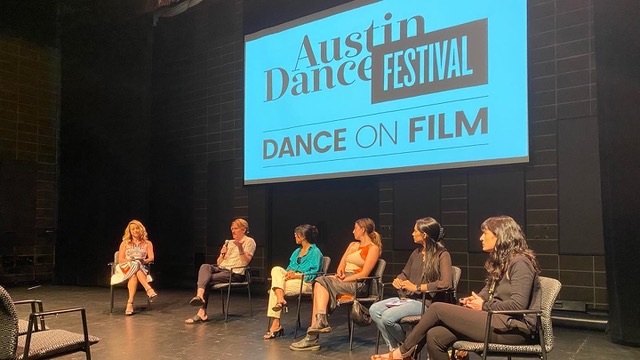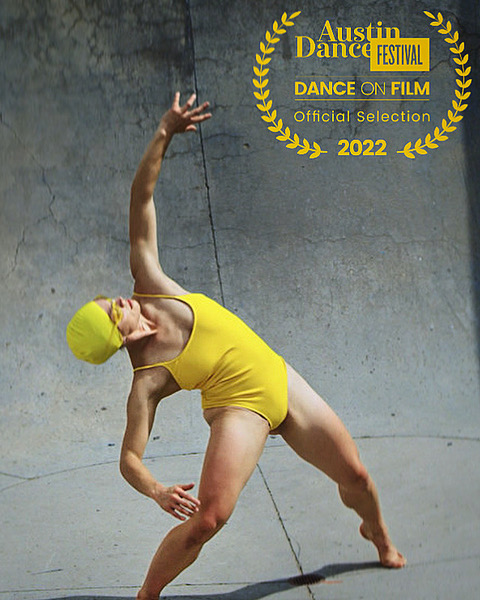Review #2 of 2: Austin Dance Festival by Kathy Dunn Hamrick Dance Company
by David Glen Robinson
Part II
 As promised, the writings and review of Austin Dance Festival 2022 for CTXLive come in two parts, largely due to the volume of artistic material presented at the festival. The event filled the Rollins Studio Theatre stage and screens at the Long Center in Austin for four days, July 14-17, 2022. The material covered here is from Dance on Film, Thursday, July 14, 2022.
As promised, the writings and review of Austin Dance Festival 2022 for CTXLive come in two parts, largely due to the volume of artistic material presented at the festival. The event filled the Rollins Studio Theatre stage and screens at the Long Center in Austin for four days, July 14-17, 2022. The material covered here is from Dance on Film, Thursday, July 14, 2022.
An added benefit of the Dance on Film segment of the festival was the Director’s Chat after each screening. An MC, Dorothy O’Shea Overbey, asked questions of the directors and dancers in the films who were in town for the fest (not all came). The discussions added depth to the films for those interested in this innovative and trending movement in dance and cinema.
Dance on Film, Thursday, July 14, 2022
On the theatrical theory of starting with a strong piece, producers Ilana Wolanow and Lisa Kobdish overdid it. They started with the strongest piece in the entire show, “The Calling,” directed by Jeff Schick. Their enthusiasm is understandable, however, because “The Calling,” clearly exemplifies the distinction between dance on film and filmed dance. The latter is merely a camera turned on dance, a lot of which is available in music videos. Dance on film is cinema using dance as core material. In this mode, dance is crafted into cinematic concepts to create a visual whole, usually a story or imagistic essay, often about dance but not exclusively. “Film dance” may be another appropriate term for it. All the tools of videography and cinematography come into play here, including screenplays and scripts written in or before preproduction.
“The Calling” is a slickly produced example of dance on film. The cinematography and editing of the piece created a story of a man drawn back to nature, forcibly. It began when he heard the irresistible something as he was negligently throwing compostable garbage into the recyclables instead of the trash or compost. He heard the siren call, the one that dragged him out of the city. Jeff Schick, who calls himself a mover but not a dancer, took this out of Greek mythology, the siren call of the Sirens, whose songs lured sailors and ships to shipwreck and death on the rocks. Schick elevates these images with the theme of the divine masculine and the divine feminine, and how one brings the other back into balance. Thomas House acted and danced the man summoned. The dramatic and powerful shapes of the large group dances, well-filmed and edited, created a movie one would love to view several times, in no small part due to the many images of the lush, cool forests of the Northwest.
“Chrysalis interrupted” directed by Fred Aube and Alberto Gutierrez and choreographed and performed by Fanny Ara, is well titled. The video framing holds tightly on Ara’s face in an expert, well-timed gestural dance. Eventually the frame widens to the upper torso. Ara explained in the Director Chat after-interviews that the concept came about when she had serious physical issues with her legs and thought she may never dance again. Then she and her collaborators developed a concept for a dance employing the upper torso only, and the film proves amply that she could certainly dance again. Film was necessary to realize the concept, and the piece was well-filmed and edited.
“Plum tree gorilla ladder” directed by Maya Gurantz and Denise Torre, is one of those rare dance films that left so little impression that it has escaped the short-term memory of this reviewer. It may have been an impressive dance, or it may have been pulled from the show after the program was printed. Total blank.
“PONY” does not suffer the same fate. The film was a powerful story dance, well-produced and edited. It did not seem like a story when it began, appearing more like a duet with a couple on their hands and knees, playing pony and trading rides. The set was concrete, either a warehouse or a parking garage. The story grew into a group dance with a lot of concern for pinkish, excelsior-type packing material layered on the floor. The dancers held shapes in stillness, many in duets in close contact. Bizarrely, a janitor figure enters and gives total attention to the removal of the packing material, entering the dance and removing it from the dancers festooned with it. Sure enough, the janitor emerged as the final soloist, dancing with skilled contemporary technique and giving a powerful ending to the film. As a final observation, the notes in the program about PONY were meaningless, perhaps misleading. The film was directed by Hannah Garner of 2nd Best Dance Company, and the dancers were Runako Campbell, Nicole Hennington, Annie Morgan, Jake Nahor, and Channce Williams.
“preheat” looks like a breakout film by young artists who are both dancer/choreographers and filmmakers. The directors were Michelle Inciarte and Oddalys Saucido, and the performers were Celeste Camfield and Oddalys Saucido. The film’s premise was the Hawthorne effect, a psychological process involving behavior change under the awareness of being watched. Camera angles established the concept, shooting through windows and peering into rooms where performers were moving. The two performers gave a showcase of athletic contemporary dance in the house where the story was set. The surprise ending came with a performer moving toward (against?) a huge interrupting force. As with most of the pieces in this show, “preheat” was very well-edited. The piece attained high quality in dance as well as film.
“’John L’ black midi.” This film was directed and choreographed by Nina McNeely and it was execrable. The piece looked more like a music video than a dance film, and one seemingly 100% CGI (computer generated imagery). The esthetic was sharp-edged with a copy-paste look, mixing black-and-white sections with brown-burgundy color palettes, mostly on the one-piece dancers’ costumes. The piece was intentionally absurdist and intended to have a distasteful look, and to offend if anyone wanted to be offended. But revulsion didn’t set in until the dancing started. A cast of seven danced in a mixed group, attired identically, with mismatching hair and facial stylings. The computer editing created multiple sections of the same dance in unison, copied and pasted onto apparent platforms at a distance visually; the effect was of a few hundred dancers instead of seven, but all making the same motions in too-perfect unison. The dancing characters danced around a towering obelisk with a pyramid cap and glaring mobile eye, the dictator in his citadel. But the dancers were rapturous, worshipping a cult leader. The program notes reported that this was a dance about an attempted overthrow of the cult leader, but there were no hints, suggestions, images, or symbols to that effect. The dance was in mockery of hip-hop, accelerated probably by video speed-up. The gestures were all full herky-jerky, high speed full extensions, muscle-ripping, tendon-stretching, ligament rupturing self-tortures, creating a sense of pain in the audience like ancient mammoth hunters separating the joints of a kill by pounding them with sharpened boulders. Percussive soundtrack to match. The dancers are likely still meeting their chiropractic appointments.
And then, dismay! Blood pours out of the obelisk, signifying the death of the leader. Then comes transformation, through video manipulation, not dance, and the pyramid cap breaks open to reveal—a baby! The new leader is a baby! Oh, it was all a good-humored joke! And that is the worst part of the piece. The producers exploited images of a happy baby to manipulate the feelings of the audience. So now we must forgive all the bad, insulting, and mocking video exercises and tropes because it was all in good, clean fun. No, we don’t.
“TIME FLIES.” This piece was directed by Kevin Chang, and choreographed and performed by Justin He and Bryan Ho. The dance was comprised of expert hip-hop and break-dancing sequences including iconic head-spinning floorwork (groundwork?) proceeded spectacularly through a rocky southern Arizona landscape of jutting rocks and desert wildflowers, brush, and cacti. Video manipulations, including slow motion effects, punctuated the dance and gave truth to the program notes that it was something that could not be performed live. Here, film and dance meshed well.
“Bridge.” The program notes described the action of the piece well. “A man working in corporate America searches within himself to break free from constructs that society has created.” This is a solo piece by a male (Jalon Turner) using athletic contemporary technique, dancing through some of the harder urban concrete and steel precincts of Houston, and later in the enclaves of nature in the marshy, flood-control impoundments near Houston. These are great contrasts, and in urban guise the man danced in corporate garb, and after he is magically given a taste of nature, he moved in more comfortable clothing. The story is old but much needed, and Turner’s dance is that of Everyman, expressing well the pressures bearing down on us all and the salvation seemingly proffered by nature. Here, the cinematography and direction were exquisite. They gave us establishing shots and details of props exactly when they needed to be made while retaining subtlety. The film side refrained from an overbearing approach leading us by the finger through a story, allowing us instead to follow the dancer and, of course, ourselves through this journey. Blake Daniels directed the piece, and it was choreographed and performed by Jalon Turner.
 “Container.” The film was one of six films in an anthology package entitled Deliquesce. The title is obscure, and if the pieces relate thematically to each other, it would be helpful to be informed of that. The piece was directed by Rebecca Aneloski and Alec Lyons. The choreographers were Brendan Duggan, Morgan Phillips, and Haleigh Larmer, performed by Phillips and Larmer. Most of the dance took place inside a large, empty concrete industrial tank, open at the top, the titular container. The performance was initially a solo, later a duet. Both performers wore tight, matching one-piece yellow swimsuits with matching yellow swim caps. The dance was largely of the high-speed, athletic, shape-oriented variety. Much contemporary dance choreography seems to borrow heavily from the vocabulary and movement repertoire of hip-hop and break-dancing.
“Container.” The film was one of six films in an anthology package entitled Deliquesce. The title is obscure, and if the pieces relate thematically to each other, it would be helpful to be informed of that. The piece was directed by Rebecca Aneloski and Alec Lyons. The choreographers were Brendan Duggan, Morgan Phillips, and Haleigh Larmer, performed by Phillips and Larmer. Most of the dance took place inside a large, empty concrete industrial tank, open at the top, the titular container. The performance was initially a solo, later a duet. Both performers wore tight, matching one-piece yellow swimsuits with matching yellow swim caps. The dance was largely of the high-speed, athletic, shape-oriented variety. Much contemporary dance choreography seems to borrow heavily from the vocabulary and movement repertoire of hip-hop and break-dancing.
“Container” is a strong example of this trend toward such blending. This reviewer believes that the approach is a leading trend in current dance. The cinematography gave us a harsh set of images, the difficult movements of the dance and the gray, unyielding concrete surface of the tank. Lighting design was similarly harsh. All of it heightened positive impressions of the athleticism, exertions, and artistry of the dancers, seemingly under difficult circumstances. A brief sequence showed the dancers splashed with water. A later scene showed the tank empty with a drying puddle of the splashed water in the bottom. Perhaps this was the direct reference to the larger anthology. Deliquesce is an intransitive verb meaning to melt away or to become liquid by absorbing moisture from elsewhere (Random House College Dictionary).
“Unspoken” was the most unusual film in the Thursday night program. It was largely an interview piece with choreographer Paul Lightfoot on the loss of his father to Covid during the pandemic lockdown. The film was directed by William Armstrong. Lightfoot told of expressing the story of his father and his death by choreographing a solo on a dancer with whom he worked, Sebastian Haynes. The story was of course emotional and intense and ultimately about Lightfoot’s choreographic process. After the interview, the dance so described was performed for video on a set inside a gorgeous cathedral, by Haynes. The dance was skilled, well-filmed and left us with no need to return to a last statement from Lightfoot.
A certain interesting feature of the videography of “Unspoken” was noted late in the viewing. The piece is from Denmark, and the video was subtitled in English. It wasn’t noted until later by this reviewer that the spoken text was also in English. In a mind-warping moment he thought he had learned Danish by psi. Perhaps the Danish film licensing commission requires all licensed films to be subtitled in English?
“Landfall” was more of a montage than a story dance, showing characters moving through calendar quality environments of saturated colors, including fields of flowers, grass, sheer mud begging to be kicked through, and bodies of water covered with water lilies through which the dancers rose to the surface. This went on for a while, and the dancers found opportunities for employing contemporary dance moves in very short phrases in almost every environment. The dance was directed by Kate Weare and Jack Flame Sorokin and choreographed by Weare. The performers were Thryn Saxon and Nicole Vaughan-Diaz. The slender women wore onesies of a light nude color, creating a costume concept called “stage nude.” They indeed looked like young naked girls exploring nature for the first time. The location selections were a major strength of the cinematography.
“Psámate.” The dance told an emotional story in a passionate duet between a man and a woman. This is an age-old trope engaged thousands of times. Perhaps only a few times has such a love duet been filmed on a rocky coastal strand in Cuba. This duet certainly was, and that was all the difference. The beach, the seaweed, the massive rocks and the deep blue dividing line of the ocean cutting horizontally through the image made this dance stand apart. The turbulent ocean set the tone for the emotionality of the dance, and it did not let up. Skilled dance and film work made for an excellent dance film. The director was Alejandro Callejas, and the choreographer was Ely Regina Hernandez Numa. And the performers were Daniela Gómez and Alejandro Silva.
Austin Dance Festival
by various companies and artists
Kathy Dunn Hamrick Dance Company
July 14 - July 17, 2022
somewhere in Austin
to be announced
Austin, TX, 78700
